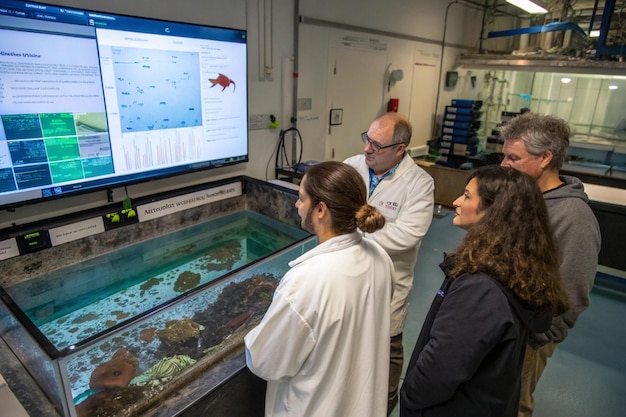Government Funding for Green Tech: 3 New US Initiatives

Discover 3 New Government Initiatives Funding Tech Solutions for Environmental Sustainability in the US, empowering innovators with financial resources to develop and deploy technologies combating climate change and promoting sustainable practices across various sectors.
The United States government is increasingly recognizing the critical role of technology in addressing environmental challenges. This has led to the launch of several new initiatives aimed at funding technological solutions for environmental sustainability. Let’s discover 3 New Government Initiatives Funding Tech Solutions for Environmental Sustainability in the US, focusing on their goals, funding mechanisms, and potential impact.
New Government Initiatives Supporting Green Tech in the US
The US government is committed to using technology to address environmental issues. Several new programs and initiatives are being launched to provide funding for those developing innovative solutions. This section will explore three prominent government initiatives that are providing financial support for environmentally sustainable technologies in the United States.
The Environmental Protection Agency (EPA) and Green Tech Grants
The EPA is one of the leading agencies in the US responsible for protecting human health and the environment. It offers various grants to support technological innovation in environmental sustainability.
- Small Business Innovation Research (SBIR) Program: This program provides funding to small businesses engaged in research and development related to environmental technologies. The SBIR program aims to foster innovation and commercialization of new technologies that can help solve environmental problems.
- Environmental Education Grants: These grants support projects that enhance environmental literacy and promote environmental stewardship. They often involve the use of technology to educate and engage the public on environmental issues.
- Clean Diesel Program: This initiative provides funding for projects that reduce emissions from diesel engines, including retrofitting existing engines with cleaner technologies and developing new, cleaner diesel engines.
The EPA’s grant programs are instrumental in supporting the development and deployment of environmentally sustainable technologies across different sectors in the United States.
Department of Energy (DOE) and Sustainable Tech Funding
The Department of Energy (DOE) plays a crucial role in supporting sustainable technology through various funding opportunities. These initiatives are designed to accelerate the development and adoption of technologies that reduce carbon emissions, promote energy efficiency, and enhance the use of renewable energy sources. This section will delve into the DOE’s key programs that are driving innovation in sustainable technology.
ARPA-E (Advanced Research Projects Agency-Energy)
ARPA-E focuses on high-risk, high-reward projects. The agency supports transformative energy technologies that can reshape the energy landscape. These projects often have the potential to create entirely new industries and address critical energy challenges that the private sector is unable or unwilling to tackle alone.

DOE Loan Programs Office (LPO)
The LPO offers loans and loan guarantees for large-scale energy projects. This includes renewable energy projects, advanced fossil fuel projects, and nuclear energy projects. The LPO helps bridge the gap between innovative technologies and commercial deployment, providing critical financial support to projects that have the potential to significantly impact the energy sector.
- Renewable Energy and Efficiency Projects: The LPO supports projects that utilize renewable energy sources such as solar, wind, and geothermal, as well as projects that improve energy efficiency in buildings and industrial processes.
- Advanced Technology Vehicle Manufacturing (ATVM) Loan Program: This program provides loans to support the development of advanced technology vehicles and components, including electric vehicles, hybrid vehicles, and fuel-efficient vehicles.
- Nuclear Energy Projects: The LPO offers loans for the development and construction of new nuclear power plants and the modernization of existing nuclear facilities.
Through these programs, the DOE strengthens the nation’s commitment towards sustainable energy and sets the stage for technological advancements that contribute to the global effort against climate change.
National Science Foundation (NSF) and Environmental Tech Research
The National Science Foundation (NSF) supports fundamental research across all fields of science and engineering. Many NSF-funded projects focus on environmental sustainability, providing crucial support for early-stage research that can lead to breakthrough technologies. Let’s explore how this agency facilitates ground-breaking studies that address climate change and promote sustainable methods.
NSF’s Role in Funding Environmental Research
The NSF plays a pivotal role in funding fundamental research that underpins the development of new environmental technologies. The agency supports a wide range of projects, from basic science to applied engineering, that address critical environmental challenges.
- Engineering Research Centers (ERCs): These centers bring together researchers from different disciplines to tackle complex engineering challenges, including those related to environmental sustainability. ERCs often focus on developing new technologies for water treatment, pollution control, and resource management.
- Materials Research Science and Engineering Centers (MRSECs): These centers support interdisciplinary research on advanced materials with potential applications in environmental technologies, such as new materials for solar cells, batteries, and fuel cells.
- Sustainability Research Network (SRN): This network supports collaborative research projects that address complex sustainability challenges, such as climate change, water scarcity, and food security. SRN projects often involve the development of new technologies and strategies for promoting sustainable development.

The NSF funds critical research initiatives that are paving the way for future innovations in the technology sector by fostering knowledge, enabling novel collaborations, and providing access to extensive resources and research networks.
Impact of Government Initiatives on Environmental Startups
Government initiatives greatly impact environmental startups by providing much-needed financial backing, guidance, and resources. These initiatives often serve as a catalyst for innovation, helping startups overcome early-stage challenges and develop viable solutions to environmental problems.
Facilitating Innovation Through Funding
One of the primary advantages of government funding is its ability to mitigate financial risks for environmental startups. Many investors are wary of the high-risk, long-term nature of environmental technology ventures. Government grants and loans provide a stable source of capital, allowing startups to focus on research, development, and scaling their technologies.
Encouraging Private Sector Investment
Government involvement often signals confidence in a startup’s potential, attracting additional investment from private entities such as venture capital firms, angel investors, and corporate partners. This blended financial approach can accelerate growth and commercialization of critical environmental technologies.
The NSF focuses on supporting interdisciplinary research on advanced materials with potential applications in environmental technologies, such as new materials for solar cells, batteries, and fuel cells, improving technology in sustainability.
Challenges and Opportunities in Government-Funded Green Tech
While government funding presents numerous opportunities for green tech development, it also entails certain challenges that companies must navigate. Understanding these hurdles and leveraging available resources can greatly enhance the chances of success.
Navigating Bureaucracy
One of the main challenges is the bureaucratic processes associated with government funding. Applying for grants and loans can be time-consuming and require significant administrative expertise. Companies must be prepared to meet stringent reporting requirements and comply with regulatory guidelines.
Ensuring Long-Term Sustainability
Relying solely on government funding can create vulnerabilities. Companies should develop strategies to diversify their funding sources and build sustainable business models. This might involve seeking private investment, generating revenue through product sales, or licensing their technologies to other organizations.
Government funding comes with both opportunities and challenges, but focusing on long-term sustainability can lead to significant technological advances.
Future Trends in Government Funding for Green Tech
Government funding for green tech is expected to increase in the coming years, driven by growing concerns about climate change and the urgent need for sustainable solutions. Several emerging trends are likely to shape the landscape of government-supported green tech initiatives.
Focus on Climate Resilience
As climate change impacts become more pronounced, funding may shift towards technologies that enhance climate resilience. This includes investments in infrastructure improvements, disaster preparedness, and adaptation strategies. Technologies that can mitigate the effects of extreme weather events, such as floods, droughts, and wildfires, will likely receive increased attention.
Emphasis on Carbon Capture and Storage
Carbon capture and storage (CCS) technologies are gaining momentum as a crucial tool for mitigating climate change. Government funding is expected to support the development and deployment of CCS projects, as well as research into innovative carbon removal technologies.
Focusing on carbon capture, climate resilience and cross-sector collaboration will lead to positive environmental change and open up new avenues for technological advancements with the help of government funding.
| Key Point | Brief Description |
|---|---|
| 🌱 EPA Grants | Supports small businesses and educational programs with environmental tech R&D. |
| ⚡ DOE Funding | Provides loans and support for renewable energy projects and advanced vehicle tech. |
| 🔬 NSF Research | Funds fundamental research in environmental science and engineering for breakthrough technologies. |
| 📈 Startup Impact | Government funding helps environmental startups innovate and attract private investment. |
Frequently Asked Questions
▼
The SBIR program provides funding to small businesses engaged in environmental technology research and development, fostering innovation and commercialization.
▼
The LPO offers loans and loan guarantees for large-scale renewable energy projects, bridging the gap between technology and commercial deployment.
▼
The NSF supports a wide range of projects, from basic science to applied engineering, addressing critical environmental challenges and promoting sustainability.
▼
Challenges include navigating bureaucratic processes, meeting stringent reporting requirements, and ensuring long-term financial sustainability.
▼
Future trends include a focus on climate resilience, emphasis on carbon capture and storage, and increased cross-sector collaboration.
Conclusion
The US government’s commitment to funding technological solutions for environmental sustainability represents a crucial step towards addressing climate change and promoting a greener future. Through initiatives led by the EPA, DOE, and NSF, innovative startups and research institutions are gaining access to vital resources that enable them to develop and deploy groundbreaking technologies. While challenges persist, opportunities abound for those willing to navigate the complexities of government funding and contribute to a more sustainable world.